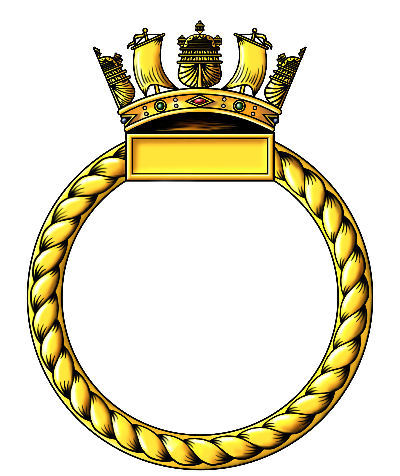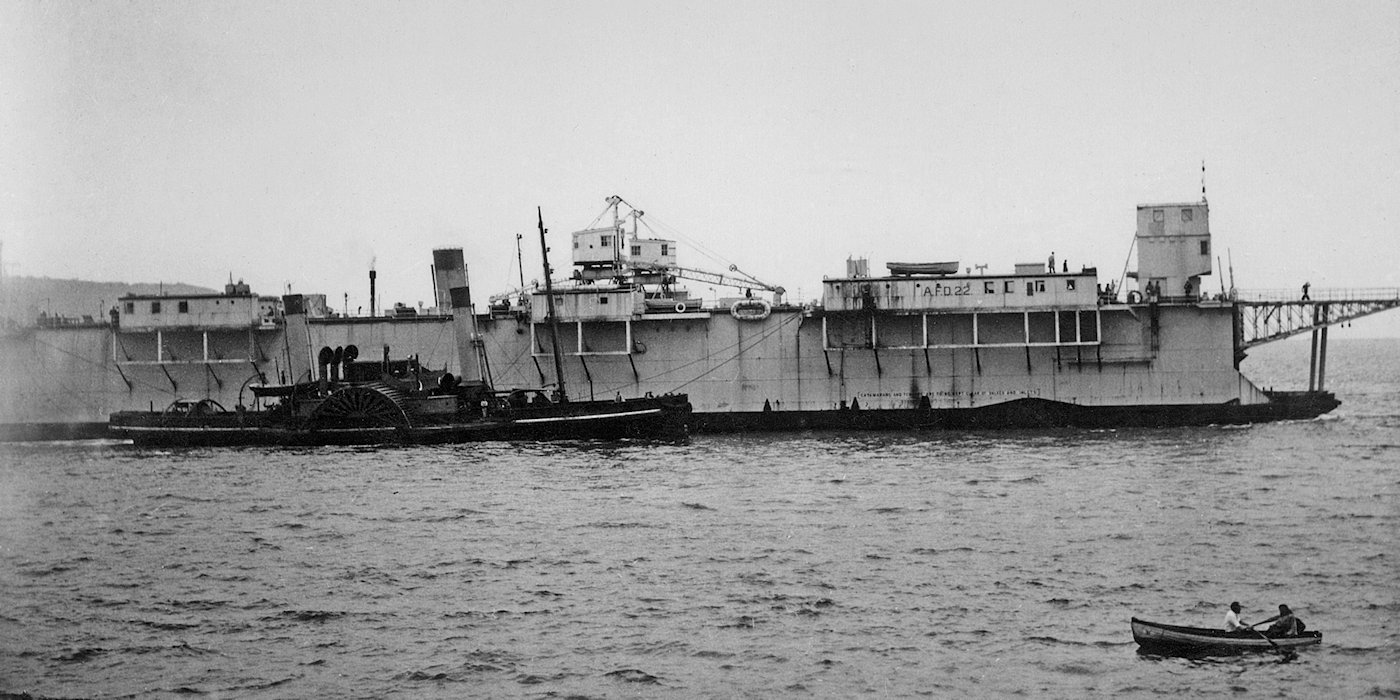Admiralty Floating Dock

Battle Honours
None
Specifications
Builder: Devonport Naval Dockyard, Plymouth, Devon, England
Length: Overall - 380 ft; Pontoons - 350 ft
Width: 50 ft internal
Lifting Capacity: 2,775 tons
Crew complement: 35
Commanding Officers
No information
Related items
None
Reminiscences
None
Gallery
None
A.F.D. 20

A 2,750 tons lifting capacity Clark Stanfield design dock
Early history
Admiralty Floating Dock No 20 was a Clark Stanfield design dock with a lifting capacity of 2750 tons, originally intended for the emergency docking of escort vessels and destroyers. She was ordered from Devonport Dockyard in June 1941 and was laid down in September.
On completion AFD20 was towed to Port Bannatyne, Kames Bay, situated near Rothesay on the Isle of Bute, Scotland as a replacement dock for AFD7. The dock was employed by HMS VARBEL, the headquarters of the 7th and 12th Submarine Flotillas, for the maintenance and repair of submarines and X-craft midget submarines. In June/July 1943 she was used for modification work to X5 to X10 which was carried out prior to the attack on Tirpitz and the dock was also used as a practice target for the raid. In 1944, the dock was utilised to train X-Craft midget submarines in preparation for attacks on the enemy held Laksevåg floating dock at Bergen, Norway; on April 15, 1944, HMS X24 attacked the Laksevåg floating dock but failed to sink her. A second operation on September 11, 1944 carried out by X24, succeeded and the dock was sunk.
Allocated to the British Pacific Fleet
In late autumn 1944, the dock was allocated to join the proposed British Pacific Fleet and was moved to Greenock to prepare her for a 13,000 mile tow to her operating area. AFD 20 left Greenock on New Years Eve 1944 under tow by ocean going Rescue Tugs HMS DESTINY and HMS EMINENT on the first leg of her tow to Gibraltar. The voyage was undertaken in stages, the dock arrived at Gibraltar January 12th where storm damage had to be repaired to her tugs, EMINENT had to remain in dockyard hands while DESTINY continued the tow to Malta. During this leg DESTINY suffered difficulties; when relieved on the tow by EMINENT once she caught up, DESTINY put into the port of Oran to make her repairs, EMINENT and AFD 20 proceeded to Bizerta where they were joined by DESTINY, and sailed for Malta, reaching there on January 27th. The group sailed for Port Said on February 1st, which they reached on the 7th. There was to be a six-day wait before they could transit the Suez Canal and continue of to Aden. On arriving at Aden on February 21st, the tugs took on fuel and departed on the 25th for the next leg to Cochin in Southern India. The Dock and her tugs arrived at Cochin early on the morning of March 10th where they waited for a second dock, AFD 18 and her tugs, to arrive before taking passage to Australia.
AFD 18 & AFD 20 departed Co-chin for Darwin in Convoy W O 4A on April 9th; AFD 18 under tow from the tugs ADVANTAGE, and CHEERLY, and AFD 20 under tow from the tugs EMINENT, and DESTINY, A fifth tug, the harbour tug EMPIRE SAM was in company towed astern of AFD 20. Escort was provided by the frigates HELFORD and PLYM, both vessels were en-route for the British Pacific Fleet. On 14th April, EMINENT had a serious fire in her engine room and was towed back to Colombo by CHEERLY. In an odd coincidence, DESTINY also had a fire, but got it successfully under control without the need for dockyard assistance. A few days later, the tow line from DESTINY to AFD 20 broke and she was adrift in the early hours of the morning; it was five hours before the tow was secured again. With the tug power halved progress was very slow but CHEERLY re-joined the convoy on April 18th and eased the situation for the other tugs. The convoy rendezvoused with the tanker EAGLES DALE on the 27th to replenish water and fuel supplies, which were running, low by this time, and supplied the vessels with other necessities. On nearing Australia, HMAS WARRNAMBOOL and HMAS INVERELL joined the convoy and these ships were ordered to escort AFD 20, and DESTINY, independently to Darwin, which was reached on May 22nd. AFD 18 continued in company with HELFORD and PLIMM, and arrived in Darwin on the 24th.
By this time, DESTINY and AFD 20 had completed a voyage of 11,313 miles, with a steaming time of 2036 hours at an average speed of 5.56 knots. The two docks resumed their journey on June 19th to their operational areas; AFD 20, still towed by DESTINY, in company with HMS EMPIRE SAM and the Australian rescue tug HMAS SPRIGHTLY, and the destroyer HMS BARLE. AFD18, now under the tow of the tug HMAS HEROS, and the salvage vessel HMS SALVESTOR, was bound for Milne Bay, Papua New Guinea with two Australian minesweepers HMAS TAMWORTH and HMAS GOULBURN as escorts.
There where several other vessels which sailed in convoy with two docks, some from Britain and others from India and Australia, including the River class escort vessels HMS HELFORD, PLYM, ODZANI, USK, and BARLE, and another Rescue Tug HMS ADVANTAGE. Some of the escort vessels continued on to Manus with AFD 20 where they were to join the escort force of the Fleet Train. On her arrival in the Admiralty Islands on June 30th, AFD 20 had been towed over 13,000 miles, possibly the longest tow in maritime history (see the account of AFD 17 which also may lay claim to this accolade). She docked her first vessel at Manus on August 20th 1945 lifting the destroyer HMAS NEPAL in order for a team from the repair ship HMS ARTIFEX to carry out repairs.
Post War
A further eight dockings were completed in the next two months before the dock was reassigned, her usefulness at Manus had come to an end and she was towed to Singapore, where she was installed at Sembawang Dockyard, Singapore naval base. No further information is currently available on this vessel.
Last modified23 February 2023:
Primary information sources
Additional sources:
Admiralty War Diaries February 1945
Electronically sourced via Fold3.com Accessed 02 January 2015
Admiralty War Diaries March 1945
Electronically sourced via Fold3.com Accessed 02 January 2015
US Naval Base, Manus, War Diary, August 1945
Electronically sourced via Fold3.com Accessed 02 January 2015
Comments (0)